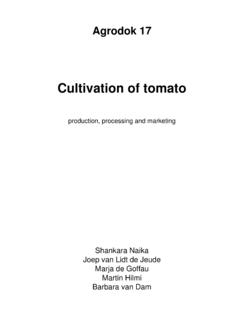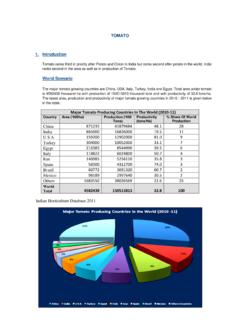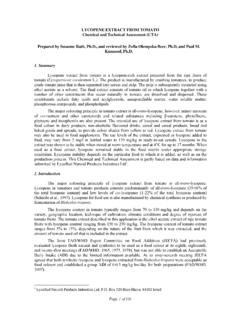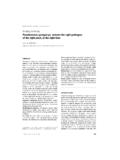Transcription of INTRODUCTION Limpopo Golden Horseshoe - Cultural Guiding
1 Limpopo Province Makiti Guides & Tours (Pty)Ltd 1 introduction Limpopo is the most northern province of South Africa. It is sometimes described as the Golden Horseshoe , which refers to the huge arc of unspoiled natural countryside. Limpopo is the gateway to the rest of Africa, and a unique feature of this province is that it shares international borders with three countries: Botswana, Zimbabwe and Mozambique, as well as the provinces of Mpumalanga, Gauteng and North West. In 1994, the province was formed from the northern region of the Transvaal, and initially named Northern Transvaal. The following year, it was renamed Northern Province, which remained the name until June 2003, when the name was formally changed to Limpopo .
2 The name is a tribute to the province most important river, the Limpopo , located on the border with Botswana and Zimbabwe. The name Limpopo is derived from the Nguni word, iLimpopo meaning rapids or waterfalls . According to legend, it was given by the fleeing army of Mzilikazi on their way to Bulawayo. This referred to the sound of the running water over some rocks where they crossed over to Zimbabwe, somewhere close to the confluence of the Limpopo and Sashe Rivers and Mapungubwe. Limpopo consists of mainly rural communities, comprising of several ethnic groups that are distinct in their cultures. The largest group are the Northern Sotho (Bapedi) accounting for more than half the population in Limpopo .
3 They are followed by the VaTsonga and VhaVenda. The Afrikaans community only accounts for a small percentage. Home to two World Heritage Sites, Mapungubwe and Makapan s Valley (annex to the Cradle of Humankind, Gauteng) and the renowned Kruger National Park. It is also the land of the Rain Queen, Modjadji and the sacred Funduzi lake. Truly, a legendary place and distinctly Africa. Limpopo Province Makiti Guides & Tours (Pty)Ltd 2 Coat of arms of Limpopo Motto Peace, Unity and Prosperity . The colours of the Coat of Arms are green, Golden yellow, red, white and black. The Buffalo: Presents unity, strength and political stability. The Shield: The government s commitment to protect human rights.
4 The Baobab: These trees, only found in the northern parts of the province, have been around for hundreds of years, providing food, healing and shelter. It symbolises the strength and steadfastness of the people. Mountain ranges in the shield: The mountains and rich agricultural lands. The coronet (small crown) with cycad leaves: Depicts royalty and encourages the continuation of traditional leadership, just as the endangered Cycads are preserved. DEMOGRAPHICS Area 123 910 km % of total area Population (Mid-year Estimates, 2006) million Languages (SA Yearbook 06-07)Sesotho sa Leboa (Sepedi) Xitsonga Tshivenda Afrikaans Races Black ( ) White ( ) Coloured ( ) Asian ( ) Unemployment rate (Labour Force Survey, March 2006) Capital Polokwane Largest city Polokwane Premier Sello Moloto (ANC) Limpopo Province Makiti Guides & Tours (Pty)Ltd 3 MUNICIPALITIES AND DISTRICTS During apartheid, the administrations of Lebowa, Gazankulu, Venda and the Transvaal were created.
5 Today, Limpopo Province is divided into five municipal district and subdivided in 24 local municipalities: Capricorn District The name "Capricorn" is derived from the tropic of Capricorn (southern tropic). The tropic of Capricorn lies 23 26 22 south of the Equator. It marks the most southerly latitude at which the sun can appear directly overhead at noon, when the southern hemisphere is tilted towards the sun to its maximum extent in December. This region stretches from the Ysterberg, all along the foothills of the Wolkberg, to the tropic of Capricorn in the north. Municipalities Aganang Blouberg Lepelle Nkumpi Molemole Polokwane Mopani District The name is derived from the local Mopane tree, growing in abundance in the region.
6 The district inherited the Maruleng Local Municipality (Hoedspruit) in March, 2006. It was previously part of the Bohlabela District Municipality that has since been dissolved. Maruleng means place of the Marula . Municipalities Baphalaborwa Giyani Letaba Tzaneen Maruleng Limpopo Province Makiti Guides & Tours (Pty)Ltd 4 Sekhukhune District The region is named after Sekhukhune, King of the Maroteng (commonly known as the Bapedi) in Sekhukhuneland during the 19th century. Sekhukhune used to be a cross-boarder municipality between Limpopo and Mpumalanga Province, but on 27 December 2005, was incorporated into the Limpopo Province in accordance with proclamation No.
7 422. Municipalities Greater Groblersdal Greater Marble Greater Tubatse Makhuduthamaga Fetakgomo Vhembe District Vhembe , meaning the receiver , is the Venda word for Limpopo . The Nzhelele River ( the giver ) flows into this major river. The district is sometimes referred to as the land of legend , so called for its rich indigenous Cultural heritage. Municipalities Makhado Musina Mutale Thulamela Waterberg District The Waterberg is the main feature and tourist attraction in this region. The name was given by the Voortrekkers when they first arrived in the area in the 1930 s. It refers to the numerous streams running down its slopes. Municipalities Belabela Lephalale Modimolle Mogalakwena Naboomspruit Thabazimbi Limpopo Province Makiti Guides & Tours (Pty)Ltd 5 GEOGRAPHICAL FEATURES OF THE LANDSCAPE The main rivers The Limpopo originates near Johannesburg as the Braamfontein Spruit and the Crocodile River, before joining the Pienaar s Rivier after the Hartbeespoort Dam.
8 It follows a course of approximately 1600km before flowing into the Indian Ocean at Xai-Xai in Mozambique. Sub continental tilt of the Angolan highlands millions of years ago, diverted much of the water from what used to be one of the mightiest rivers in Africa, to the Okavango and Zambezi Delta. The major rivers flowing into the Limpopo (Vhembe) River The major rivers feeding it in the north, include the Sand-, Nzhelele- ( the giver ), Nwanedi and the Luvuvhu Rivers. Others, draining the western regions of the Bushveld Crocodile Matlabas Mokolo Lephalala Mogalakwena The major rivers, draining the eastern regions and flowing into the Indian ocean: The Letaba Olifants River Shingwedzi The main mountain ranges Drakensberg Escarpment The Dragon mountains or Mountain of Spears (Ukhakhlamba) as it is known in Zulu, forms the eastern border of the Bushveld.
9 It starts in the vicinity of Tzaneen and includes the Wolkberg. The Strydpoort Mountains is a western spur of the Drakensberg, running towards Mokopane. It is believed, that the two Voortrekker leaders, Hans van Rensburg and Louis Trichardt had some differences, because ever since they moved through the defile ( poort ) in these mountains in 1836, it has been known as strydpoort ( defile of conflict or struggle ). Limpopo Province Makiti Guides & Tours (Pty)Ltd 6 Waterberg Stretches from Thabazimbi to Mokopane. Average elevation: 600m Some peaks exceed : 1400m Soutpansberg The most northern mountain range in South Africa Situated to the north of Louis Trichardt (Makhado).
10 Lebombo mountains It forms the border between the Kruger National Park and Mozambique. Springbok flats An extensive, featureless plain that is part of the Bushveld. It stretches on either side of the Pretoria-Zimbabwe railway. Northern boundary: Strydpoort mountain Western boundary: Waterberg Range Eastern boundary: Olifants River The name was derived form the fact that in the 18-19th centuries, thousands of springbok roamed these parts before they were wiped out. Average altitude: 1000m Rainfall: 600m per annum Limpopo Province Makiti Guides & Tours (Pty)Ltd 7 ROUTES The Great North Road The major route is the N1, or also known as the Great North or Cape to Cairo road.








